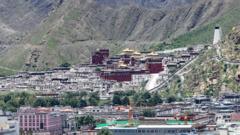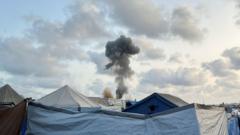At least 32 lives have been lost, and 38 individuals sustained injuries following a strong earthquake that struck the Tibet region on Tuesday morning. Chinese state media confirm that a powerful tremor, measuring 7.1 in magnitude, shook Shigatse city around 09:00 local time (01:00 GMT). The seismic event, which originated at a depth of 10 kilometers (approximately six miles), was significant enough to trigger several aftershocks in the region, also causing tremors felt in neighboring Nepal and parts of India.
Tremors of Tragedy: Death Toll Rises After Tibet's Earthquake

Tremors of Tragedy: Death Toll Rises After Tibet's Earthquake
A devastating earthquake in Tibet has claimed numerous lives and injured many as rescue efforts unfold.
Shigatse, a city of great spiritual importance in Tibetan Buddhism, is situated on a major geological fault line, making it prone to seismic activities. The Chinese government has reported a slightly lower magnitude of 6.8 but indicated serious consequences, including damage to over 1,000 houses. Images circulating on social media depict significant structural collapses amidst ongoing aftershocks, suggesting the full extent of destruction may yet be determined.
According to Jiang Haikun, a researcher at the China Earthquake Networks Center, after a major earthquake, a gradual attenuation process ensues. While shockwaves of around 5 in magnitude are possible, he reassured audiences that the prospect of more severe quakes remains unlikely.
Rescue operations have been mobilized by the Chinese air force, employing drones to survey and assist in the affected high-altitude areas near Mount Everest, where frigid temperatures pose additional challenges. Meanwhile, power and water infrastructure in the region have been compromised.
In Nepal, local officials in the Namche region, adjacent to Everest, reported no damage or casualties despite experiencing substantial tremors. As the situation unfolds, Tibet's earthquake bureau is currently working to verify casualty figures, highlighting the dangers inherent in this seismically active region where the Indian and Eurasian tectonic plates converge. The last major incident of this nature was the catastrophic 2015 earthquake near Kathmandu, which took nearly 9,000 lives and left over 20,000 injured.
According to Jiang Haikun, a researcher at the China Earthquake Networks Center, after a major earthquake, a gradual attenuation process ensues. While shockwaves of around 5 in magnitude are possible, he reassured audiences that the prospect of more severe quakes remains unlikely.
Rescue operations have been mobilized by the Chinese air force, employing drones to survey and assist in the affected high-altitude areas near Mount Everest, where frigid temperatures pose additional challenges. Meanwhile, power and water infrastructure in the region have been compromised.
In Nepal, local officials in the Namche region, adjacent to Everest, reported no damage or casualties despite experiencing substantial tremors. As the situation unfolds, Tibet's earthquake bureau is currently working to verify casualty figures, highlighting the dangers inherent in this seismically active region where the Indian and Eurasian tectonic plates converge. The last major incident of this nature was the catastrophic 2015 earthquake near Kathmandu, which took nearly 9,000 lives and left over 20,000 injured.























